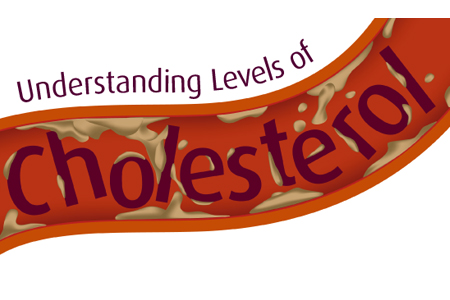
Understanding Levels of Cholesterol
Issue 84 September 2011
Cholesterol levels are said to be particularly high amidst the South Asian communities. As a caution to large Eid-feasts, Dr. Noreen Kassem breaks down this risky condition and identifies what you can do to maintain a healthy diet.
You are probably aware that you should eat less fatty foods, and that high cholesterol is unhealthy and can lead to serious conditions such as heart disease and stroke. However, eating the right fats is also essential for your good health and some types of good cholesterol can actually help prevent heart attacks and other cardiovascular diseases. Thus it is important to be able to decipher the difference.
Fats are an important part of a balanced diet and are naturally present in all the membranes of the cells in your body. Almost two-thirds of your brain is composed of fats, and fatty acids from the fats you ingest are also what make up the myelin or protective covering of the nerve cells in the brain and spinal cords—giving you the ability to move, feel and think.
Fats are also critical for the development of the eyes, brain and spinal cord in developing babies and growing infants. During pregnancy, the mother supplies the foetus with fatty acids and other nutrients and minerals from what she consumes. Deficiencies in the mother’s own diet can lead to low birth weight and small head circumference, as well as slowed development of cognitive activity and the central nervous system. After the birth of the baby, the mother continues to supply the baby with essential fatty acids through breast-feeding.
During digestion, fats from the foods you eat are broken down into fatty acids in your intestines. From here, they are absorbed into your bloodstream. Your liver then turns these fatty acids into cholesterol—a waxy, fat-like substance. Your body requires cholesterol to produce vital hormones such as oestrogen and testosterone, produce and use vitamin D, and manufacture bile acids that are important in the digestion of fats. However, depending on the type of fatty foods consumed, you may have unhealthy or healthy levels and types of cholesterol.
Healthy vs Unhealthy Cholesterol
Too much cholesterol in your blood can lead to heart and vascular diseases such as atherosclerosis or atheroma, which is a stiffening and narrowing of the arteries. Coronary heart disease occurs when the coronary arteries of your heart become blocked or narrowed. A stroke can occur if the carotid arteries to the brain become clogged.
Molecules called lipoproteins are types of fats that have varying functions in the body. The three main types are trigylcerides, low-density lipoprotein (LDL) and high-density lipoprotein (HDL). Trigylcerides are unhealthy cholesterol and accumulate in the cells and blood vessels. LDL is also unhealthy, and is referred to as “lethal” cholesterol. High levels of LDL indicate an increased risk of cardiovascular disease. LDL carries cholesterol produced by the liver to the cells of the body, and can cause fatty plaque to build up in the arteries. HDL is considered healthy cholesterol and is sometimes referred to as “heroic” cholesterol. HDL transports excess, unhealthy cholesterol from the arteries, cells and blood back to the liver where it is broken down and excreted from the body.
Hence, a high risk of heart disease and stroke occurs if you have high levels of triglycerides and LDL and low levels of HDL. Your total cholesterol is a sum of all these levels.
In the UK, doctors recommend healthy levels to be less than 5.0 mmol/l for your total cholesterol, less than 3.0 mmol/l for your LDL cholesterol and 1.2 mmol/l or more for your HDL cholesterol.
A ratio of total cholesterol to HDL of 4.5 or less is also important because a higher HDL level is better for any level of cholesterol. However, these recommended cholesterol values vary depending on other risk factors. For example, if you suffer from diabetes, your target level for LDL and total cholesterol should be even lower, and your HDL even higher.
High cholesterol can occur in people that eat a healthy, balanced diet and who have a healthy weight. This can occur due to inherited problems in how your body produces and processes cholesterol, a condition called familial hypercholesterolaemia.
A family history of stroke or heart disease may also indicate that you are vulnerable. You are particularly at risk if you have a father or brother who suffered a stroke or developed heart disease before the age of 55, or a mother or sister before the age of 65.
Certain ethnicities carry genetic traits that have a higher risk of heart disease and stroke. These include family ancestry from India, Pakistan, Bangladesh and Sri Lanka. Your doctor can prescribe medication and other treatment in addition to a healthy balanced diet, if you are unable to control your cholesterol levels.
Cholesterol in your Diet
Cholesterol is rarely found in foods. However, saturated fat from the foods you eat is transformed into cholesterol in your body. Therefore, eating less fat; particularly saturated fats, helps to balance cholesterol levels.
You require essential fatty acids from foods for good health. These healthy fats include omega-6 and omega-3 fatty acids and eating a balance of these fats helps to control cholesterol levels and reduce your risk of cardiovascular disease. However, western diets are typically overindulgent in omega-6 fats and contain too little omega-3 fatty acids, leading to unhealthy cholesterol levels.
Good sources of omega-3 include fresh, green, leafy vegetables, flax and other seeds, walnuts and other nuts and fish such as salmon, trout, mackerel and sardines. Foods that contain omega-6 fatty acids include vegetable oils such as corn, sunflower, safflower and sesame oils.
To help balance healthy fats and cholesterol levels, consume less sugar and sugary foods such as white flour and white rice and avoid saturated fats such as those found in margarine, butter and other shortening.
You should also attempt to avoid processed meats like salami and sausages, and replace them with lean meats like turkey breast, or cooked lean chicken. Similarly, it is beneficial to avoid snack foods like crisps, heavy consumption of takeaway foods, especially those which are heavily fried and cakes, biscuits and pastries.
In most people, your cholesterol level reflects the amount of fat that you eat. But this is not the full story, as different people who eat the same amount of fat can make different amounts of cholesterol. However, in general, if you eat less fat, your cholesterol level is likely to reduce.
In some people, a high cholesterol level is due to another condition such as an underactive thyroid gland, obesity, or some rare kidney and liver disorders, which can also raise cholesterol levels. If you are concerned about your cholesterol level, you should consult your doctor.
There are numerous risk factors for cholesterol. Some of these are directly linked to diet, whereas others could have links to genetics, general lifestyle or illnesses. Varying risk factors include:
- Gender — statistics show that men are at an increased risk of developing the condition. Although women have a lower risk factor due to the protective effects of the hormone oestrogen, early menopause can increase the risk in some cases.
- A sedentary lifestyle with not enough or minimal exercise can cause high levels of cholesterol. This is most common in people with a desk job or full-time drivers who are unlikely to get a large amount of exercise.
- Smoking can cause unnecessary blockage in your artieries and increases your risk of developing high levels of cholesterol.
- Being overweight and/or obese will mean you are more prone to suffering from high levels of cholesterol.
- An unhealthy diet with too much salt or sugar (or both) can also affect levels.
- Other chronic illnesses such as diabetes, high blood pressure or kidney disease.
Bookmark this |
|
Add to DIGG |
|
Add to del.icio.us |
|
Stumble this |
|
Share on Facebook |
|
Share this |
|
Send to a Friend |
|
Link to this |
|
Printer Friendly |
|
Print in plain text |
|


Comments
0 Comments